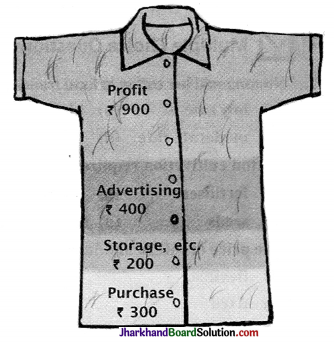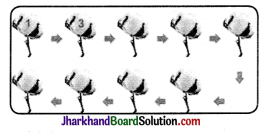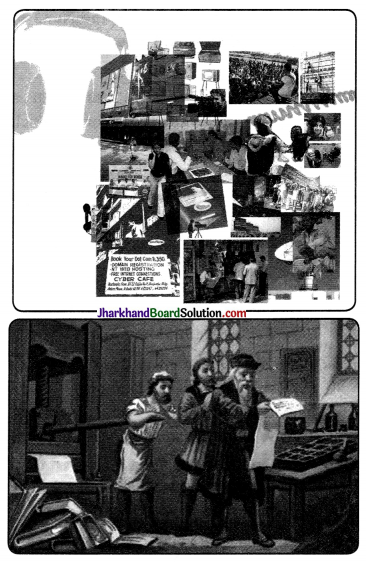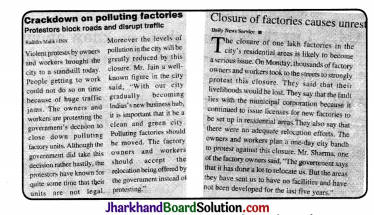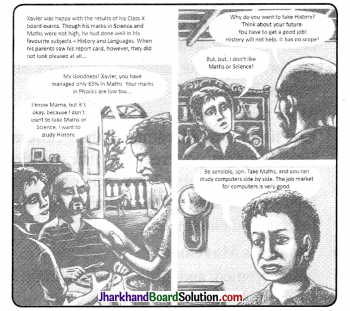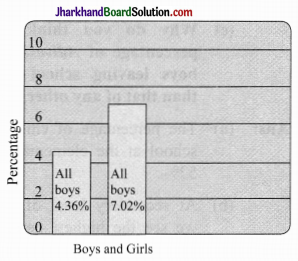JAC Board Class 7th Social Science Solutions History Chapter 6 Towns, Traders and Craftspersons
JAC Class 7th History Towns, Traders and Craftspersons InText Questions and Answers
Page 75
Question 1.
What would a traveller visiting a medieval town expect to find?
Answer:
A traveller visiting a medieval town is expected to find out what type of a town it is temple town, administrative centre, commercial town or a port town, etc.
Page 76
Question 2.
Why do you think people regarded Thanjavur as a great town?
Answer:
People regarded Thanjavur as a great town because of the following reasons: It was the capital of Chola empire which was a temple town with Rajarajeshvara temple in it. It also gave employment to a large number of people hence becoming a centre of opportunities. It had a big market selling food, cloth, jewellery, etc.

Page 77
Question 3.
What do you think were the advantages of using Bronze, bell metal and the “lost wax” technique?
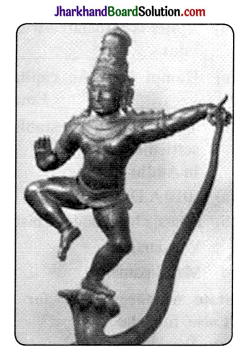
Answer:
The Tost wax’ technique had the following advantages:
- Wax was a reusable material and a quick way to make statues of any shape.
- When the metal were cooled and solidified, the clay cover was removed. The Bronze statues were not at all hollow from inside and had long life. The Bronze statues were not at all hollow from inside. They were solidified and had long life.
Page 78
Question 4.
Make a list of towns in your district and try to classify these as administrative centres or as temple/pilgrim centres.
Answer:
Need to do it yourself. Hint: Can take help from parents and subject teacher.
Page 79
Question 5.
Find out more about present-day taxes on markets: who collects these, how are they collected and what are they used for.
Answer:
Present-day taxes on markets:
- They are the property tax, service tax, etc.
- Central or State government collect these taxes through revenue departments. This department works with other departments to collect and use the money.
- They are collected in cash.
- The money collected is used for welfare and development of the society. Moreover, these taxes help in infrastructure development of the nation.
Page 80
Question 6.
As you can see, during this period there was a great circulation of people and goods. What impact do you think this would have had on the lives of people in towns and villages? Make a list of artisans living in towns.
During this period, the great circulation of people and goods must had have following impacts on the lives of people living in towns and villages:
- They would have become busier and engaged than ever before and their incomes must have increased.
- Their time must have reduced for the family as they would have started giving more time to the commercial activities.
List of artisans living in towns were:
- Blacksmith
- Weavers
- Metal worker
- Potters
- Brass dealers
- Goldsmith
- Wood carver
- Gardener
- Tailors
Page 83
Question 7.
Why do you think the city was fortified?
Answer:
Hampi was a trade as well as temple town. And temples, were the centres of wealth and the honour of kings. In order to protect the people from the attack of the enemy, the town of Hampi was fortified.
Page 85
Why did the English and the Dutch decide to establish settlements in Masulipatnam?
The English and the Dutch decided to establish settlements in Masulipatnam because Masulipatnam was the most important port of the Andhra coast. It had the convenience of the place where ship can anchor. It was the trade town connected to the hinterland. Due to all such reasons, the Dutch and the English decide to establish settlements in Masulipatnam.

Page 88
Question 9.
Imagine, you are planning a journey from Surat to West Asia in the seventeenth century. What are the arrangements you will make?
Answer:
If I would plan a journey from Surat to West Asia in the 17th century. I would make the following arrangements:
- I would get a confirmed reservation in one of the ships travelling on the route.
- I would send some money to West Asia through hundi, as it would not be wise to carry money on a ship journey.
- I would look for if I could do some businesses on my journey.
JAC Class 7th History Towns, Traders and Craftspersons Textbook Questions and Answers
Question 1.
Fill in the blanks:
(a) The Raj arajeshvara temple was built in……..
(b) Ajmer is associated with the Sufi saint…… .
(c) Hampi was the capital of the………. Empire.
(d) The Dutch established a settlement at…… in Andhra Pradesh.
Answer:
(a) 1010 A.D.
(b) Khwaja Muinuddin Chisti
(c) Vijayanagara
(d) Masulipatnam
Question 2.
State whether ‘True’ for true and ‘False’ for false.
(a) We know the name of the architect of the Rajarajeshvara temple from an inscription.
(b) Merchants preferred to travel individually rather than in caravans.
(c) Kabul was a major centre of trade for elephants.
(d) Surat was an important trading port on the Bay of Bengal.
Answer:
(a) True
(b) False
(c) False
(d) False
Question 3.
How was water supplied to the city of Thanjavur?
Answer:
Thanjavur was situated near the pemninal river Kaveri. It was from this river that was water supplied to the city. Water supplied to the city of Thanjavur came from tanks and wells.
Question 4.
Who lived in the “Black Towns” in cities such as Madras (now Chennai)?
Answer:
During the eighteenth century, the cities such as Bombay, Calcutta and Madras were formed. During this period, the crafts and commerce underwent major changes as merchants and artisans (such as weavers) were moved into the ‘Black Towns’ established by the European companies within these new cities. The ‘blacks’ or native traders and crafitspersons were confined here while the ‘white’ rulers occupied superior residencies of Fort St. George in Madras or Fort St. William in Calcutta.
(Let’s Understand)
Question 5.
Why do you think towns grew around temples?
Answer:
Towns grew around temples because the temple towns represented a very important pattern of urbanisation. Temples were considered central to the economy and society. The following reasons are:
- A large number of people like priests, workers, artisans, traders, etc., settle near the temples to cater its needs.
- Temples were mostly the central hub to the economy and society.
- Rulers built temples, donated land and money to carry out elaborate rituals, feed pilgrims and priests and celebrate festivals.
- Pilgrims also made donations to the temples.
- Temple authorities used their wealth to finance, trade and banking.
Question 6.
How important were craftspersons for the building and maintenance of temples?
Answer:
The Panchalas or Vishwakarma community consisting of goldsmiths, bronzesmiths, blacksmiths, masons and carpenters. The community played an essential role in the building of temples. They had an important role in the construction of big buildings, palaces, tanks and reservoirs. They executed the following activities:
1. The craftspersons of Bidar were well known for their inlay work in copper and silver and it was known as Bidri.
2. During the eighteenth century, the cities such as Bombay, Calcutta and Madras were formed. During this period, the crafts and commerce underwent major changes as merchants and artisans (such as weavers) were moved into the ‘Black Towns’ established by the European companies within these new cities. The ‘blacks’ or native traders and craftspersons were confined here while the ‘white’ rulers occupied superior residencies of Fort St. George in Madras or Fort St. William in Calcutta.
3. Weavers like Saliyar and Kaikkolars were very prosperous communities and they often donated money to temples.
Question 7.
Why did people from distant lands visit Surat?
Answer:
Surat was a cosmopolitan city and people of all castes and creeds lived there. People from distant lands visited Surat for the following reasons:
- Surat was one of the most important medieval ports on the west coast of Indian subcontinent.
- The Portuguese, Dutch and English had their factories and warehouses at Surat during the seventeenth century.
- Surat was gateway for trade with West Asia via the Gulf of Ormuz.
- It has also been called the gateway to Mecca, because many pilgrims’ ship set sail from here.
- The big market for cotton textiles was present. There were also several retail and wholesale shops selling cotton textiles.
- Surat was also famous for the textiles with gold lace borders (zari) which had a market in West Asia, Europe and Africa.
- The Kathiawad seths or mahajans (moneychangers) had huge banking houses at Surat. Also, the Surat hundis were honoured in the far-off markets of Cairo in Egypt, Basra in Iraq and Antwerp in Belgium.
- Magnificent buildings and pleasure parks also attracted people from far- off places. They had ample of rest houses for visitors and traders.
Question 8.
In what ways was craft production in cities like Calcutta different from that in cities like Thanjavur?
Answer:
| Craft production in Calcutta |
Craft production in Thanjavur |
| It was in the form of cotton, jute and silk textiles. |
It was oganised and planned by the European companies. |
| They had to produce whatever was demanded by the European companies. |
It was in the form of inlay work in metals such as copper and silver. |
| The production mainly focused on the needs of the temple and the pilgrims. |
They were free to be as much creative as they could be. |
(Let’s Discuss)
Question 9.
Compare any one of the cities described in this chapter with a town or a village with which you are familiar. Do you notice any similarities or differences?
Answer:
Do it yourself. Hint: Take the present-day of New Delhi
- Similarities
- Mention about Parliament and about Justice means Supreme Court.
- Many people from distant places visit here and many traders and powerful people live here.
- It is cultural and economic development centre. Also provides employment opportunities, etc.
- Differences-(with Thanjavur)
- Much larger area and had an elaborate transportation system.
- It also experiences unlawful activities.
- Migrants come everyday in search of work to Delhi, etc.
Question 10.
What were the problems encountered by merchants? Do you think some of these problems persist today?
Answer:
The problems encountered by the merchants were:
- Merchants travelled in caravans carrying goods on the back of horses and camels. They had to travel through forests and there was always the fear of robbers.
- But the European Companies’ used their naval power to gain control
of the sea trade and forced Indian traders to work as their agents.
- In the market also, they had to face tough competition with European traders.
- Yes, some problem still persists today.
(Ie?sDo)
Question 11.
Find out more about the architecture of either Thanjavur or Hampi, and prepare a scrap book illustrating temples and other buildings from these cities.
Answer:
Do it yourself. Hint: Can take help from sources like books, articles, internet, etc.

Question 12.
Find out about any present-day pilgrimage centre. Why do you think people go there? What do they do there? Are there any shops in the area? If so, what is bought and sold there?
Answer:
Do it yourself.
Hint: Present day pilgrimage centre: Tirupati. People go to this place and do worship and follow certain rituals. They go to famous Balaji temple. There are many shops and hotels. People visit and stay for few days. Offering materials are . also sold in these shops.
JAC Class 7th History Towns, Traders and Craftspersons Important Questions and Answers
Multiple Choice Questions
Question 1.
Thanjavur served as the capital under the reign of……. rulers.
(a) Shakya
(b) Mughal
(c) Chola
(d) Chauhan
Answer:
(c) Chola
Question 2.
Mandapas or pavilions were used for
(a) training soldiers
(b) assembly meetings and carrying out administrative works and issuing orders
(c) imparting knowledge of art and craft to women
(d) None of the above
Answer:
(b) assembly meetings and carrying out administrative works and issuing orders
Question 3.
A holy lake named Pushkar is situated near which city?
(a) Ajmer
(b) Jaipur
(c) Udaipur
(d) Bikaner
Answer:
(a) Ajmer

Question 4.
The built the fort of Masulipatnam.
(a) Portuguese
(b) French
(c) English
(d) Dutch
Answer:
(d) Dutch
Question 5.
Group of muslim merchants are known as…….
(a) Noors
(b) Moors
(c) Hoors
(d) None of these
Answer:
(b) Moors
Question 6.
Surat is located on
(a) the banks of the river Ganga
(b) the banks of the river Tapti
(c) the banks pf the river Jhelum
(d) the banks of the river Yamuna
Answer:
(b) the banks of the river Tapti
Question 7.
Domingo Paes was
(a) an Arab traveller
(b) a French traveller
(c) a Portuguese traveller
(d) a Spanish traveller
Answer:
(c) a Portuguese traveller
Question 8.
Great Indian traders such as ….. and ….owned a large number of ships which competed with East India Companies.
(a) Mulla Abdul Ghafur, Virji Vora
(b) Mir Zafar, Mir Jumla
(c) Mulla Abdul Ghafur, Mir Zafar
(d) None of these
Answer:
(a) Mulla Abdul Ghafur, Virji Vora
Question 9.
The Rajarajeshvara temple was located in……
(a) Bijapur
(b) Thanjavur
(c) Hampi
(d) Masulipatnam
Answer:
(b) Thanjavur
Question 10.
Which city was known as Gateway of Asia?
(a) Hampi
(b) Calcutta
(c) Bombay
(d) Surat
Answer:
(d) Surat
Very Short Answer Type Questions
Question 1.
Which type of sculpture is famous from Thanjavur?
Answer:
Bronze idols are famous from Thanjavur.
Question 2.
Why do you think the temples become so important and powerful in medieval India?
Answer:
The temples became so important and powerful in medieval India because rulers gave a lot of money and grant land for temple development.
Question 3.
Write names of two famous guilds of the 8th century from the southern part of India.
Answer:
Manigramam and Nanadesi are the two famous guilds of the 8th century from the southern part of India.
Question 4.
Give an example of a temple town.
Answer:
Thanjavur was a temple town.

Question 5.
European gain control of the sea route. How did they do that?
Answer:
European gain control of the sea route as they used their naval power to get authority of the sea trade.
Question 6.
What do you mean by emporium?
Answer:
A plage where goods from diverse production centres are bought and sold is called emporium. Such as, Surat was the emporium of Western trade.
Question 7.
India did trade with Africa. What did they brought?
Answer:
India did trade with Africa. They brought ivory and gold.
Question 8.
Which spices became the part of European cooking?
Answer:
Spices which were grown in tropical climates such as pepper, cinnamon, nutmeg, dried ginger, etc., became an important part of European cooking.
Question 9.
From which place did the Gujarati traders imported spices, tin, Chinese blue pottery and silver?
Answer:
From Southeast Asia and China, Gujarati traders imported spices, tin, Chinese blue pottery and silver.
Question 10.
Name some important temple towns.
Answer:
Some important temple towns are Thanjavur, Bhillasvamin in Madhya Pradesh, Somnath in Gujarat, Kanchipuram, Madurai in Tamil Nadu and Tirupati in Andhra Pradesh.
Short Answer Type Questions
Question 1.
Which ruler tried to play off Dutch and English against each other and why?
Answer:
Since the Mughals began to extend their power to Golconda, their representative the governor Mir Jumla who was also a merchant, began to play off the Dutch and the English against each other.
Question 2.
What do you mean by hundi? Who used hundi and in which city it was used?
Answer:
Hundi is a note recording and a deposit made by a person. The amount deposited can be claimed in another place by presenting the record of the deposit. The Kathiawad seths or mahajans (moneychangers) had huge banking houses at Surat. In Surat, hundis were honoured in the far-off markets of Cairo in Egypt, Basra in Iraq and Antwerp in Belgium.
Question 3.
Which type of markets did the small towns had?
Answer:
Small towns usually had a mandapika (or mandi of later times) to which nearby villagers brought their produce and things to sell. They also had market streets called hatta (haat of later times) lined with shops. Also, there were streets for different kinds of artisans such as potters, oil pressers, sugar makers, toddy makers, smiths, stonemasons, etc.

Question 4.
Give reasons for the decline of Surat.
Answer:
Surat began to decline towards the end of the seventeenth century because of the following reasons:
- Due to the decline of the Mughal Empire there was the loss of markets and productivity.
- The sea routes were controlled by the Portuguese and competition from the English East India Company which shifted its headquarters to
Question 5.
The most impressive community was the Vora community. Discuss.
Answer:
In India, the trading communities were quite large in number and assimilated some of the richest merchants and traders in the world. Virji Vora who dominated Gujarat trade for several decades had a large fleet of ships. Mulla Abdul Ghafur was one of the noteworthy big merchants.
Question 6.
Name the main centres of cotton manufacturing.
Answer:
The main centres of cotton manufacturing were Patna, Cambay and Ahmedabad, Burhanpur, Bengal, Kashmir, Lahore and United Provinces.
Question 7.
Which trading groups made the city, Masulipatnam populous and prosperous?
Answer:
The trading groups which made the city of Masulipatnam populous and prosperous were the Golconda nobles, Persian merchants, Telugu Komati Chettis and European traders.
Question 8.
If weavers wanted to sign deals with the East India Company, they couldn’t sell their own cloth or weave their own patterns. Why?
Answer:
If weavers wanted to sign deals with the East India Company, they couldn’t sell their own cloth or weave their own patterns because they had to work on a system of payments in advance which meant that they had to weave cloth which was already promised to European agents.

Question 9.
Write any three distinct type of urban centres in the medieval period.
Answer:
The three distinct types of urban centres in the medieval period were:
- Administrative towns Delhi, Agra, Lahore, etc.
- Commercial and manufacturing towns Daulatabad, Patna, Ahmedabad, Muziris, Surat, Hampi, Masulipatnam, etc.
- Pilgrim towns Banaras, Kanchipuram, Mathura, etc.
Question 10.
Briefly explain the Mughal Karkhanas.
Answer:
The karkhanaa in the Mughal period were known as Buyutat as well. It was used for both storing and manufacturing articles for the royal household and nobles requirements. Following sections come under the karkhanas, such as public treasury, department of construction of monuments, repairing, roads and artillery.
Long Answer Type Questions
Question 1.
Explain the different ventures and occupations of big and small traders
in the medieval period.
Answer:
The different ventures and occupations of big and small traders in the medieval period were:
- Many types of traders were there. It included Banjaras and various traders especially horse traders. ‘ They formed associations with headmen with warriors who bought horses.
- Caravans were usually used by traders to travel and formed guilds to protect their interests.
- Communities were present such as Marwari Oswals and Chettiars who later become the main trading groups of the country.
- Gujarati traders which include the communities of Hindu Baniyas and Muslim Bohras traded enormously with the ports of Red Sea, Persian Gulf, East Africa, China and South East Asia.
- They majorly sold textiles and spices in these towns and in return brought ivory and gold from Africa and silver, tin, spices, Chinese blue pottery from China and South East Asia.
- Many traders such as Persian, Chinese, Arab, Syrian Christian, Jewish traded in the towns on the west coast.
- Indian spices and cotton cloth became the source of attraction for the European traders. And, eventually reached the European markets fetching high profits.
Question 2.
Hampi was in its peak time in the 16th centuries. How? When did it fall to ruin?
Answer:
Hampi was in its peak time in the fifteenth and sixteenth centuries because:
- It was a very important centre for commercial and cultural activities.
- Moors which means a name used collectively for Muslim merchants, Chettis and agents of European traders such as the Portuguese, visited the markets of Hampi for different trades.
- Temples were the main focal point of cultural activities and devadasis means temple dancers performed different forms of dances before the deity, royalty and masses in the many-pillared halls in the Virupaksha which is a form of Shiva temple.
- The Mahanavami festival which is known today as Navaratri was one of the most important festivals celebrated at Hampi.
- During the Mahanavami platform, the king received guests and accepted tribute from subordinate chiefs. From here he also watched dance and music performances which held during the festival time as well as wrestling bouts.
- By the defeat of Vijayanagara in 1565 by the Deccani Sultans which were the rulers of Golconda, Bijapur, Ahmadnagar, Berar and Bidar, Hampi fell into ruin.
JAC Class 7 Social Science Solutions
GLENMARK Pivot Calculator

